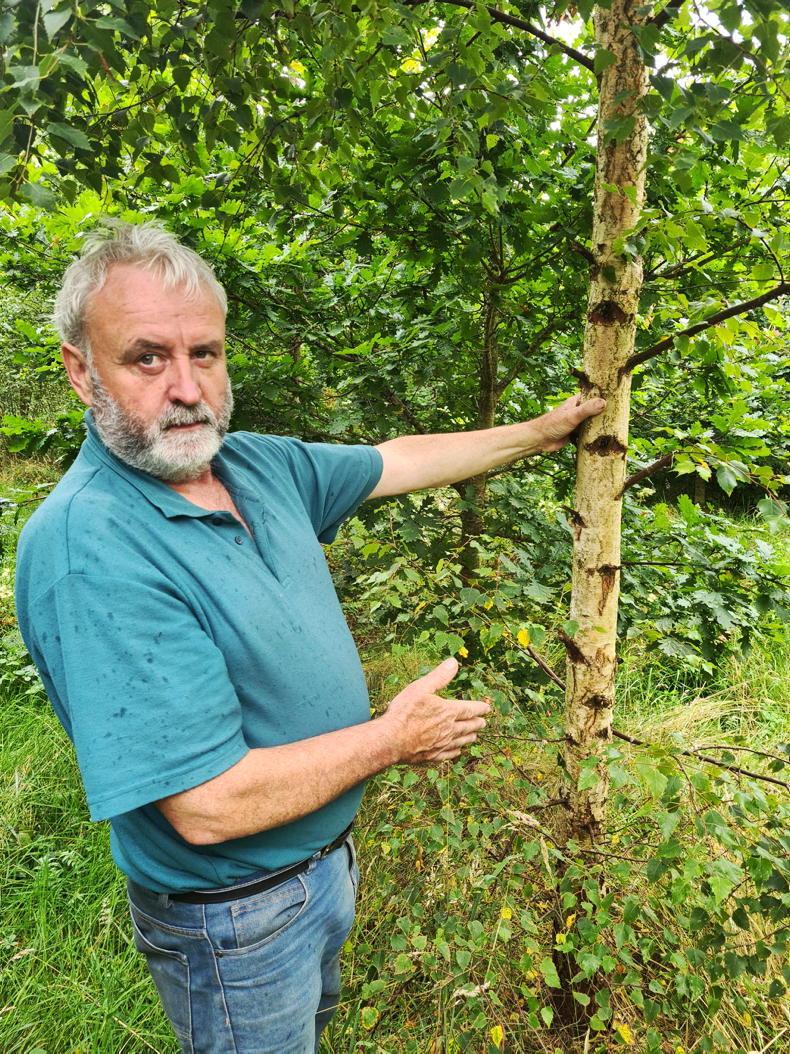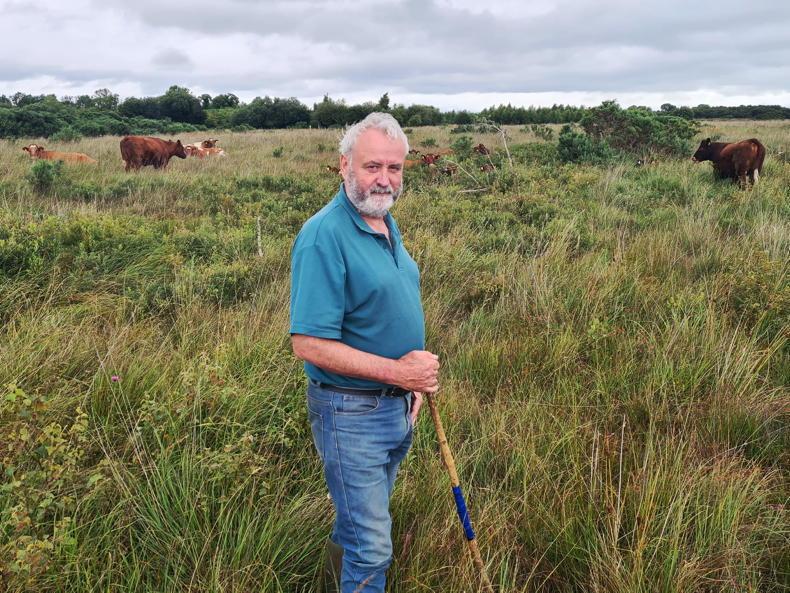With another annual Heritage Week behind us, it’s encouraging to see communities across Ireland celebrate our cultural, built and natural heritage.
While, like many countries, our heritage resource may have been significantly depleted in recent decades, we are fortunate to retain a great richness, thanks in no small part to farmers like Noel Kiernan based near Lough Ree in Co Longford.
Noel is a farmer, forester and conservationist – three professions you may not often see listed in one CV, but which are very much embodied in this one man.
Noel’s vision for his landholding is a place where balance has been restored between what are often seen as competing land uses for food, trees and heritage but which, for Noel, are naturally compatible and entirely complementary.
Indeed, when visiting Noel’s farm recently, I witnessed a wonderful blend of natural and semi-natural habitats from peatland to pasture, lakeshore to callows, fen to forestry.
All are helping to support several birds of prey (kestrels, buzzards and even a white-tailed sea eagle), dragonflies and damselflies, a contented herd of cattle and a farmer who clearly relishes this natural abundance.
Learning the trade
Noel grew up on the family farm near Mullingar where his brother still farms, but it was while working with his uncle Jim in Drumlish, north Longford, that his farming perspective and skills were honed, and his respect for rural heritage deepened.
Over 15 years he cocked hay, learned the secret of growing ‘great’ potatoes and worked closely with the natural attributes of the land and livestock.
Qualifications
By this time, Noel had qualifications as a forester, a profession which paid the bills while allowing him to indulge in his long-standing love of nature.
As well as his hands-on work as a professional forester – from planning to planting – he also worked closely with tree charity, Crann, to promote trees in the Irish landscape, citing Crann’s Jan Alexander and Cathy Fitzgerald as great supporters.
In 2005, Noel bought his current farm using a bank loan and proceeds from the sale of his uncle’s land. He was attracted by its suitability for forestry and for farming but, when he later bought an adjacent parcel, his primary motivation in doing so was to conserve what he rightly felt was a very special area for wildlife, which might otherwise be lost.
Heritage focus
The common thread in Noel’s farming system is, clearly, heritage. His herd of 15 to 20 cows are kept as part of efforts to help restore the rare Bó Riabhach cow, with several cattle displaying the characteristic black ‘streaks’ or ‘brindles’.
With kind temperaments and reputedly great milkers, the number of Bó Riabhach cattle remaining in Ireland today is estimated at 150.
Noel also keeps a flock of 40 Roscommon ewes, an estimated 250 of which remain nationally.

A retired forester, Noel with a birch tree on his farm’s broadleaved plantations.
Famed for their long, heavy fleeces and large frames, and long associated with the midlands, Noel describes them as docile and prolific.
The farm also hosts a herd of feral Lough Ree Goats, while even the honey bees are of the native Irish black bee variety.
The cattle herd function as important conservation grazers, creating space and light for a range of orchids and other wildflowers to prosper, from which an abundance of invertebrates benefit the core of a rich web of farm wildlife. The goats too help browse back encroaching gorse and birch.
Noel has planted sections (about 100 acres) of the land with a range of trees – birch, alder, oak, spruce and pine are prominent. Rarer native species like buckthorn, black poplar, whitebeam, bird cherry and guelder rose are also grown, partly for seed collection and propagation.
Though retired from professional forestry, Noel intends planting more trees on the farm (through the Native Woodland and ash dieback schemes), finding they provide a steady, reliable income, a buffer against external shocks, and a pension.
Balance
While his stocking levels are low, so too are input costs. Noel finds his healthy soils yield ‘abundantly’ (he produces 150 silage bales annually for winter feed).
Income-wise, there is good demand for breeding female heifers and ewes (most customers have an interest in rare breeds) which, along with organic grants, Noel reckons generate a decent return for his time spent farming.

Noel Kiernan with his cattle herd near the eastern shore of Lough Ree.
However, for Noel, income is just one dividend: equally important is the sense of wellbeing, tranquillity, purpose and pride offered by the land and its stewardship.
While his attitude and approach are hardly conventional and mightn’t suit many, it clearly works for Noel.
His farm is a really wonderful heritage repository and his story offers a timely reminder of the potential of our farmers to sustain our priceless natural and cultural heritage, a role which warrants society’s respect and support.
Formed in 1986 with the aim of re-leafing Ireland, Crann is dedicated to the promotion and protection of our trees, hedgerows and woodlands visit www.crann.ie. For information on Bó Riabhach cattle, visit www.boriabhachsociety.ie.Information on Roscommon sheep on Facebook: www.facebook.com/roscommonsheep/. Top tip
“Try not to go against nature, as it will surely bite back. Run with it for an easier life,” says Noel.
Name: Noel Kiernan.Farm type: suckler beef, sheep and forestry. Farm size: 103ha.Focus: finding an equilibrium between farming, forestry and nature. Schemes: organics, forestry premium scheme.
With another annual Heritage Week behind us, it’s encouraging to see communities across Ireland celebrate our cultural, built and natural heritage.
While, like many countries, our heritage resource may have been significantly depleted in recent decades, we are fortunate to retain a great richness, thanks in no small part to farmers like Noel Kiernan based near Lough Ree in Co Longford.
Noel is a farmer, forester and conservationist – three professions you may not often see listed in one CV, but which are very much embodied in this one man.
Noel’s vision for his landholding is a place where balance has been restored between what are often seen as competing land uses for food, trees and heritage but which, for Noel, are naturally compatible and entirely complementary.
Indeed, when visiting Noel’s farm recently, I witnessed a wonderful blend of natural and semi-natural habitats from peatland to pasture, lakeshore to callows, fen to forestry.
All are helping to support several birds of prey (kestrels, buzzards and even a white-tailed sea eagle), dragonflies and damselflies, a contented herd of cattle and a farmer who clearly relishes this natural abundance.
Learning the trade
Noel grew up on the family farm near Mullingar where his brother still farms, but it was while working with his uncle Jim in Drumlish, north Longford, that his farming perspective and skills were honed, and his respect for rural heritage deepened.
Over 15 years he cocked hay, learned the secret of growing ‘great’ potatoes and worked closely with the natural attributes of the land and livestock.
Qualifications
By this time, Noel had qualifications as a forester, a profession which paid the bills while allowing him to indulge in his long-standing love of nature.
As well as his hands-on work as a professional forester – from planning to planting – he also worked closely with tree charity, Crann, to promote trees in the Irish landscape, citing Crann’s Jan Alexander and Cathy Fitzgerald as great supporters.
In 2005, Noel bought his current farm using a bank loan and proceeds from the sale of his uncle’s land. He was attracted by its suitability for forestry and for farming but, when he later bought an adjacent parcel, his primary motivation in doing so was to conserve what he rightly felt was a very special area for wildlife, which might otherwise be lost.
Heritage focus
The common thread in Noel’s farming system is, clearly, heritage. His herd of 15 to 20 cows are kept as part of efforts to help restore the rare Bó Riabhach cow, with several cattle displaying the characteristic black ‘streaks’ or ‘brindles’.
With kind temperaments and reputedly great milkers, the number of Bó Riabhach cattle remaining in Ireland today is estimated at 150.
Noel also keeps a flock of 40 Roscommon ewes, an estimated 250 of which remain nationally.

A retired forester, Noel with a birch tree on his farm’s broadleaved plantations.
Famed for their long, heavy fleeces and large frames, and long associated with the midlands, Noel describes them as docile and prolific.
The farm also hosts a herd of feral Lough Ree Goats, while even the honey bees are of the native Irish black bee variety.
The cattle herd function as important conservation grazers, creating space and light for a range of orchids and other wildflowers to prosper, from which an abundance of invertebrates benefit the core of a rich web of farm wildlife. The goats too help browse back encroaching gorse and birch.
Noel has planted sections (about 100 acres) of the land with a range of trees – birch, alder, oak, spruce and pine are prominent. Rarer native species like buckthorn, black poplar, whitebeam, bird cherry and guelder rose are also grown, partly for seed collection and propagation.
Though retired from professional forestry, Noel intends planting more trees on the farm (through the Native Woodland and ash dieback schemes), finding they provide a steady, reliable income, a buffer against external shocks, and a pension.
Balance
While his stocking levels are low, so too are input costs. Noel finds his healthy soils yield ‘abundantly’ (he produces 150 silage bales annually for winter feed).
Income-wise, there is good demand for breeding female heifers and ewes (most customers have an interest in rare breeds) which, along with organic grants, Noel reckons generate a decent return for his time spent farming.

Noel Kiernan with his cattle herd near the eastern shore of Lough Ree.
However, for Noel, income is just one dividend: equally important is the sense of wellbeing, tranquillity, purpose and pride offered by the land and its stewardship.
While his attitude and approach are hardly conventional and mightn’t suit many, it clearly works for Noel.
His farm is a really wonderful heritage repository and his story offers a timely reminder of the potential of our farmers to sustain our priceless natural and cultural heritage, a role which warrants society’s respect and support.
Formed in 1986 with the aim of re-leafing Ireland, Crann is dedicated to the promotion and protection of our trees, hedgerows and woodlands visit www.crann.ie. For information on Bó Riabhach cattle, visit www.boriabhachsociety.ie.Information on Roscommon sheep on Facebook: www.facebook.com/roscommonsheep/. Top tip
“Try not to go against nature, as it will surely bite back. Run with it for an easier life,” says Noel.
Name: Noel Kiernan.Farm type: suckler beef, sheep and forestry. Farm size: 103ha.Focus: finding an equilibrium between farming, forestry and nature. Schemes: organics, forestry premium scheme. 







 This is a subscriber-only article
This is a subscriber-only article










SHARING OPTIONS: